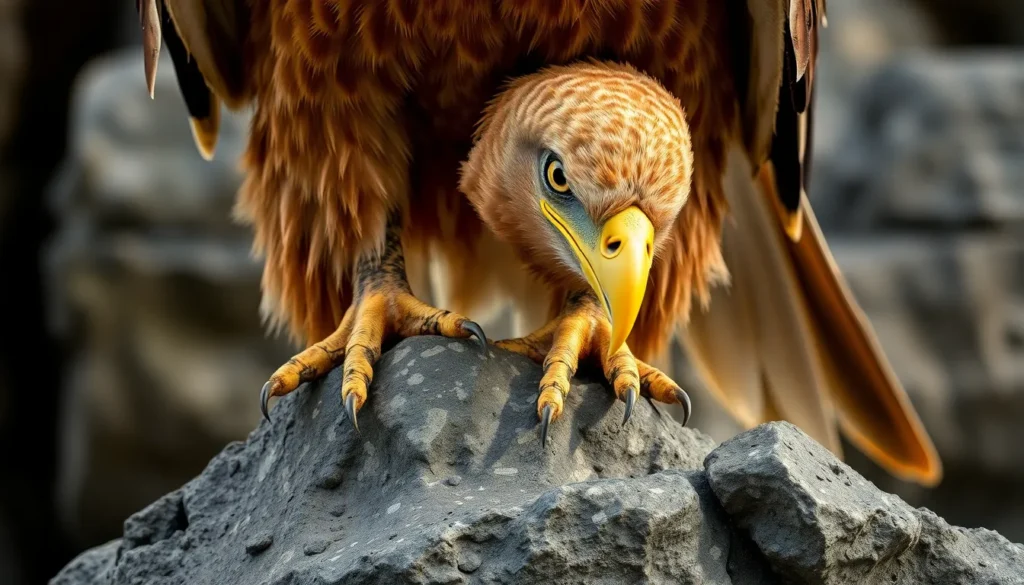Birds possess some of nature’s most impressive hunting tools – their razor-sharp talons. These curved claws aren’t just for show; they’re sophisticated weapons that have evolved over millions of years to help our feathered friends survive in the wild.
We’ve all watched in awe as an eagle swoops down to snatch its prey or seen an owl’s silent approach before those deadly talons strike. But there’s so much more to these remarkable appendages than meets the eye. From the massive talons of golden eagles that can exert over 750 pounds per square inch of pressure to the needle-sharp claws of tiny songbirds, each species has developed unique adaptations.
Understanding bird talons reveals fascinating insights into avian behavior, hunting strategies, and evolutionary biology. Whether you’re a birdwatcher, nature enthusiast, or simply curious about wildlife, we’ll explore how these incredible tools work and why they’re essential for bird survival.
What Are Bird Talons?
Bird talons are specialized curved claws that extend from the toes of raptors and other predatory birds. These sharp structures consist of keratin, the same protein found in human fingernails, but grow continuously throughout a bird’s lifetime to maintain their razor-sharp edges.
Raptors use their talons as primary hunting weapons to capture, kill, and carry prey. The curved shape allows birds to puncture vital organs and maintain a deadly grip on struggling animals. Each talon connects to powerful tendons and muscles in the bird’s legs, creating a hydraulic-like gripping system that can exert tremendous pressure.
Different bird species display varying talon configurations based on their hunting strategies and prey preferences. Eagles possess four talons on each foot, with the rear talon (hallux) being the largest and most powerful for delivering fatal strikes. Hawks feature similarly curved talons but often display more uniform sizing across all four digits. Owls have specialized talons with feathered legs that muffle sound during silent night hunts.
The gripping strength of bird talons varies dramatically across species:
| Bird Species | Grip Strength (PSI) | Primary Prey |
|---|---|---|
| Bald Eagle | 400-750 | Fish, waterfowl |
| Golden Eagle | 750-1,000 | Mammals up to 30 lbs |
| Peregrine Falcon | 300-400 | Small to medium birds |
| Great Horned Owl | 300-500 | Mammals, birds, reptiles |
Talon maintenance occurs naturally through regular use and perching on rough surfaces. Birds also engage in preening behaviors to keep their claws clean and properly shaped. When talons become overgrown in captivity or due to injury, they can impair a bird’s ability to hunt and perch effectively.
We observe that talon anatomy directly correlates with hunting success rates in wild bird populations. Research shows that birds with damaged or malformed talons experience significantly reduced prey capture rates compared to those with healthy claws.
Anatomy and Structure of Bird Talons
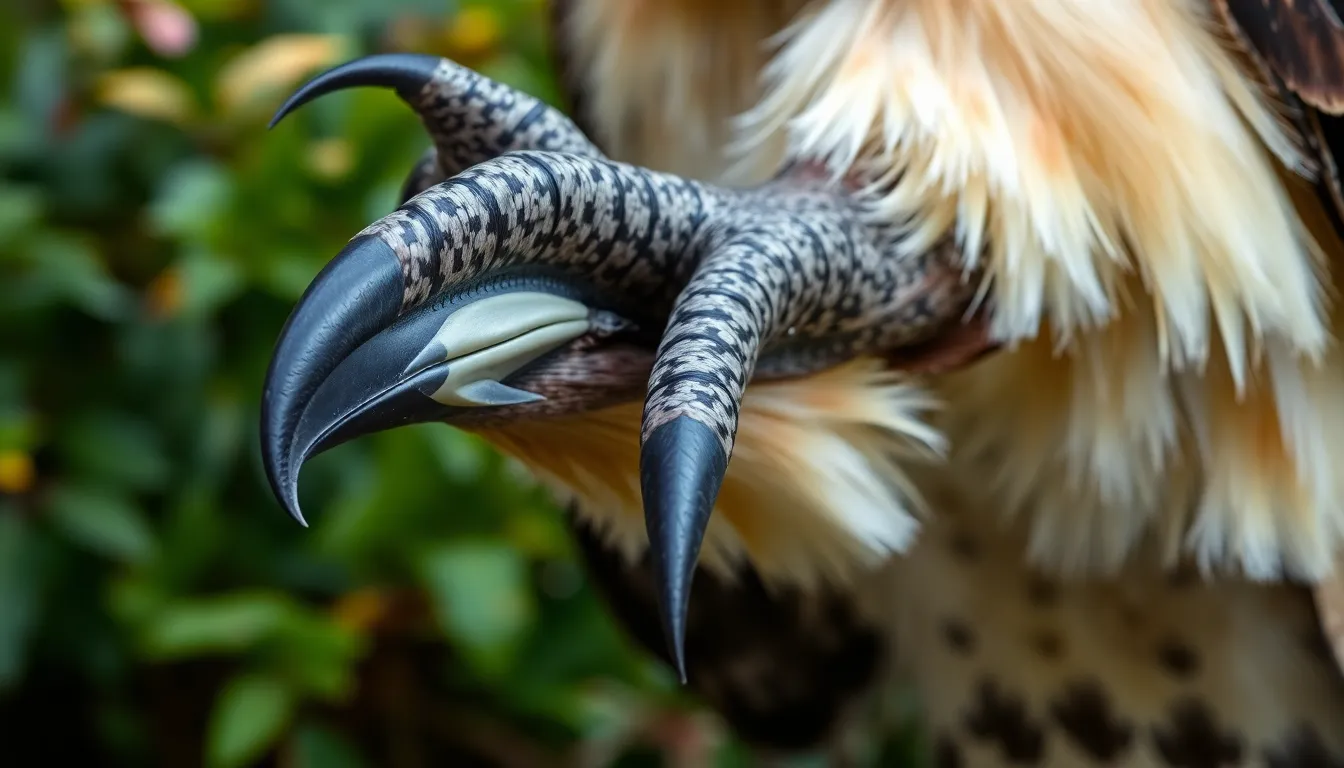
Bird talons possess a sophisticated anatomical design that maximizes their effectiveness as hunting instruments. We examine three critical structural components that determine their performance in capturing and securing prey.
Keratinous Composition
Talons consist entirely of keratin, the same protein found in human fingernails and bird feathers. This keratin structure grows continuously throughout a bird’s lifetime, replacing worn material at rates of 0.5 to 2 millimeters monthly depending on species size and activity levels. The keratin layers form dense, overlapping plates that create exceptional durability while maintaining flexibility during strikes.
Multiple keratin types combine within each talon to create varying hardness zones. The outer surface contains harder beta-keratin that resists wear from rocky surfaces and bone contact. Inner layers feature softer alpha-keratin that provides shock absorption during high-impact prey captures. This dual-layer system allows talons to penetrate tough hide while preventing fractures from sudden impacts.
Curved Design and Sharp Points
The curved architecture of bird talons follows precise geometric principles that optimize puncturing efficiency. Most raptor talons curve at angles between 60 and 90 degrees, creating natural hooks that prevent prey from escaping once grasped. Peregrine falcons possess talons with 75-degree curves that slice through feathers and penetrate muscle tissue with minimal resistance.
Talon points taper to dimensions measured in micrometers, creating needle-sharp tips that concentrate force over minimal surface areas. These microscopic points generate pressures exceeding 300 pounds per square inch during strikes. The gradual taper from base to tip distributes stress evenly, preventing breakage while maintaining penetrating power through multiple hunting cycles.
Blood Supply and Nerve Endings
Rich vascular networks supply nutrients to growing keratin structures through specialized blood vessels called digital arteries. These vessels branch into capillary beds within the talon’s core, delivering oxygen and proteins required for continuous growth. Blood flow increases during molting periods when talons experience accelerated replacement rates.
Dense concentrations of nerve endings throughout the talon base provide exceptional tactile sensitivity. These mechanoreceptors detect pressure variations as small as 0.1 grams, allowing birds to adjust grip strength instantly based on prey size and struggle intensity. Proprioceptive nerve fibers monitor talon position and movement, enabling precise placement during complex aerial maneuvers. The nerve network extends into the curved portions, providing feedback about penetration depth and tissue resistance during strikes.
Types of Bird Talons by Species
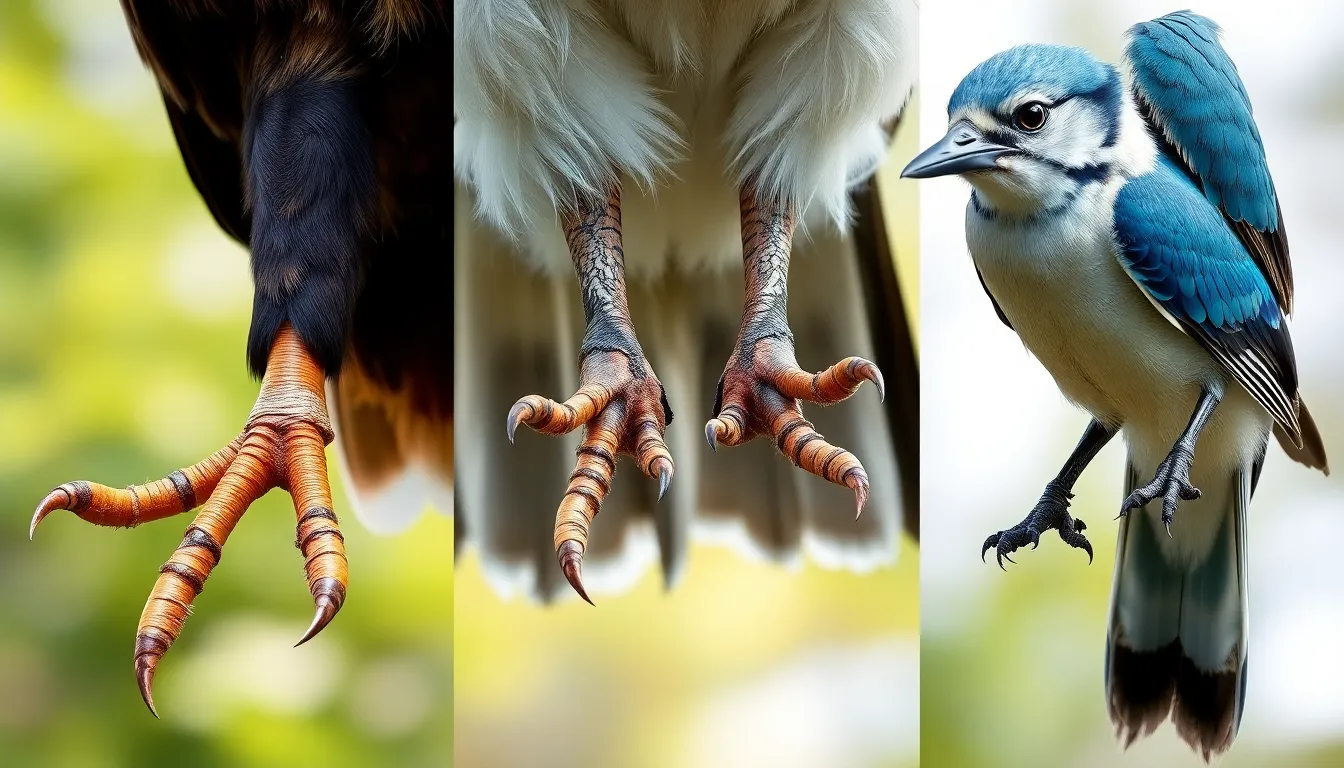
Bird species have developed distinct talon configurations based on their hunting strategies and ecological niches. Each group exhibits specialized adaptations that reflect millions of years of evolutionary refinement.
Raptors and Birds of Prey
Raptors possess the most formidable talons in the avian industry. Eagles, hawks, falcons, and owls feature curved, razor sharp claws designed for capturing and killing prey.
Bald eagles generate grip forces up to 750 pounds per square inch with their massive talons. Golden eagles exceed this power with forces reaching 900 PSI, allowing them to crush bones and penetrate thick hide. Peregrine falcons use their streamlined talons to strike prey at speeds exceeding 240 mph during hunting dives.
Great horned owls demonstrate exceptional talon versatility with their silent flight capabilities. Their talons measure up to 3 inches in length and can rotate to face backward, providing superior gripping angles. Harpy eagles possess the largest talons among raptors, with rear claws measuring 5 inches long.
The talon arrangement in raptors follows a three forward, one backward pattern that maximizes prey retention. This zygodactyl configuration enables birds to maintain deadly grips on struggling animals while preventing escape.
Climbing Birds
Climbing species have evolved specialized talon structures for vertical movement and bark penetration. Woodpeckers, nuthatches, and treecreepers showcase distinct adaptations for arboreal lifestyles.
Pileated woodpeckers feature curved talons with reinforced keratin layers that resist wear from constant contact with tree bark. Their zygodactyl foot arrangement includes two toes facing forward and two backward, creating anchor points during vertical climbing. Red breasted nuthatches possess shorter, more curved talons that function like grappling hooks on smooth bark surfaces.
Brown creepers display needle sharp talons measuring 0.5 inches in length with extreme curvature angles reaching 90 degrees. These adaptations allow them to navigate tree trunks in spiraling patterns while maintaining secure footing. Black capped chickadees combine climbing abilities with perching functions through medium length talons that curve moderately.
Tree climbing birds maintain their talons through constant use against rough bark surfaces, naturally filing the keratin to optimal sharpness levels.
Perching Birds
Perching birds exhibit diverse talon configurations adapted for exact feeding behaviors and habitat requirements. Songbirds, finches, and corvids demonstrate remarkable variety in their claw structures.
Cardinals possess robust talons measuring 0.25 inches with moderate curvature for seed cracking and branch gripping. American robins feature longer, thinner talons optimized for ground foraging and worm extraction from soil. Blue jays combine perching abilities with manipulative functions through their versatile talon design.
House finches showcase specialized seed eating adaptations with blunt tipped talons that provide stability during feeding. Crows and ravens possess the most robust talons among perching birds, measuring up to 0.75 inches with enhanced gripping strength for manipulating objects and caching food.
The anisodactyl toe arrangement in perching birds places three toes forward and one backward, optimizing branch gripping efficiency. This configuration generates sufficient holding power to support the bird’s weight during sleep and adverse weather conditions.
Functions and Uses of Bird Talons
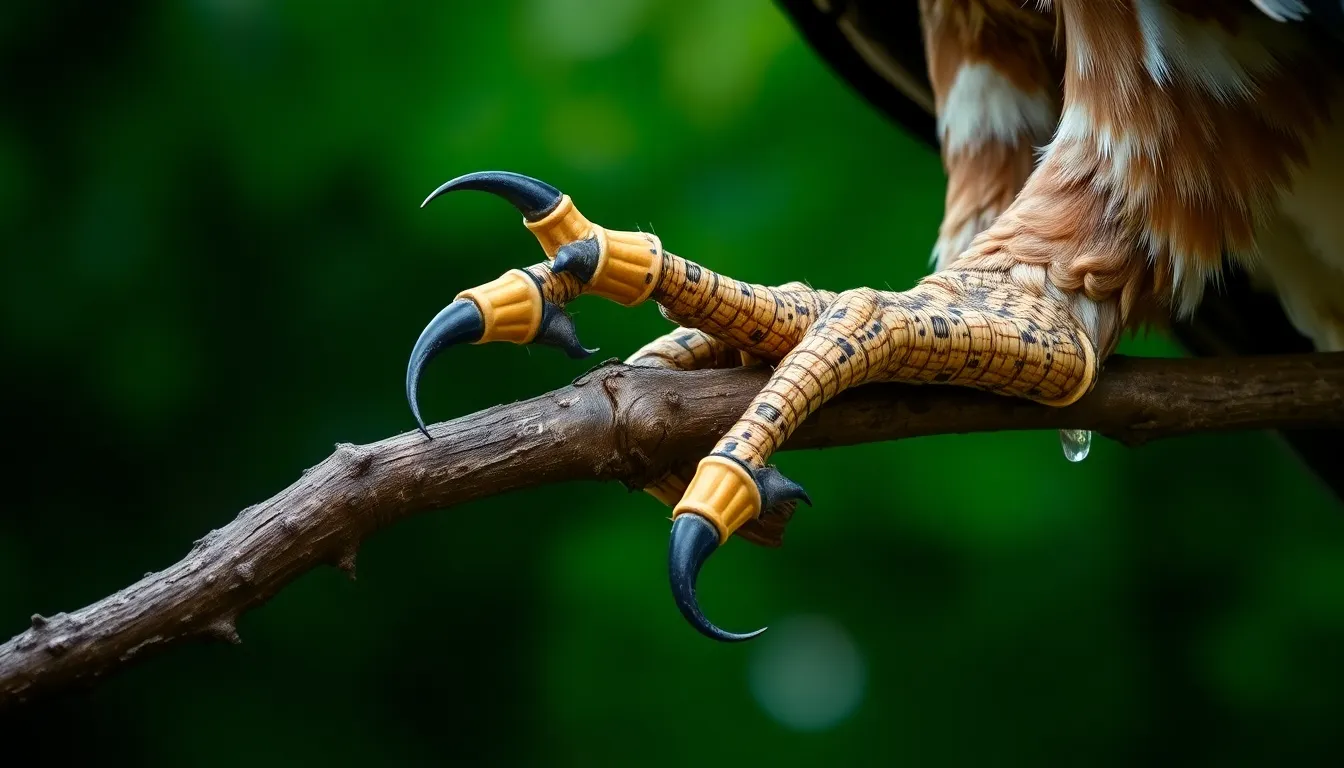
Bird talons serve multiple critical functions that extend far beyond their primary role as hunting instruments. These specialized structures enable birds to survive in diverse environments through three essential applications that demonstrate their evolutionary versatility.
Hunting and Capturing Prey
Raptors deploy their talons as precision weapons during hunting sequences, striking prey with calculated force that often proves instantly lethal. Golden eagles generate talon pressure exceeding 750 pounds per square inch when capturing medium-sized mammals like rabbits and marmots. Peregrine falcons use their rear talons to deliver killing blows during high-speed aerial attacks, puncturing vital organs within seconds of contact.
Different raptor species employ distinct talon strategies based on their preferred prey types. Osprey possess reversible outer toes that rotate backward, creating a two-forward, two-backward grip configuration that secures slippery fish during flight. Great horned owls use their silent flight approach combined with needle-sharp talons to ambush prey in complete darkness, relying on their exceptional tactile sensitivity to locate vital strike points.
Hunting success rates correlate directly with talon sharpness and grip strength across raptor populations. Research data shows that raptors with damaged or dulled talons experience hunting success reductions of up to 60%, emphasizing the critical importance of talon maintenance for survival.
Gripping and Perching
Perching birds use their talons as sophisticated anchoring systems that enable stable positioning on branches, wires, and vertical surfaces. Songbirds like robins and cardinals engage their flexor tendons automatically when landing, creating a locked grip that requires no conscious muscle effort to maintain. This passive gripping mechanism allows birds to sleep on branches without falling, as their body weight naturally tightens the talon grip.
Climbing specialists demonstrate advanced talon adaptations for vertical movement on tree bark and rock surfaces. Woodpeckers possess zygodactyl feet with two toes facing forward and two backward, distributing grip pressure evenly across four contact points. Nuthatches use their sharp, curved talons to navigate headfirst down tree trunks, a behavior impossible without their specialized gripping configuration.
Talon length and curvature vary significantly among perching species based on their preferred surfaces and feeding behaviors. Finches exhibit shorter, less curved talons optimized for seed manipulation and small branch gripping, while larger perching birds like crows possess longer, more robust talons suitable for varied perching surfaces and food handling tasks.
Self-Defense Mechanisms
Birds employ their talons as defensive weapons when threatened by predators, competing individuals, or humans approaching nesting sites. Raptors rear up on their backs and extend their talons forward when cornered, creating a formidable defensive barrier capable of inflicting serious injury. Great blue herons use their dagger-like middle talons to strike at threats approaching their nesting colonies, often targeting eyes and exposed skin.
Territorial disputes frequently involve talon combat between competing birds, particularly during breeding seasons when nesting sites become premium resources. Male red-tailed hawks engage in aerial talon grappling, locking claws mid-flight and spiraling toward the ground before separating at the last moment. These dramatic displays establish dominance hierarchies without typically resulting in serious injury.
Parent birds demonstrate fierce talon defense when protecting their young from potential threats. Owls and hawks strike repeatedly at intruders approaching their nests, using their talons’ piercing capability to discourage persistent threats. Mother birds often position themselves between threats and their offspring, extending their wings and presenting their talons in threatening postures that effectively communicate their readiness to fight.
How Bird Talons Grow and Maintain Themselves
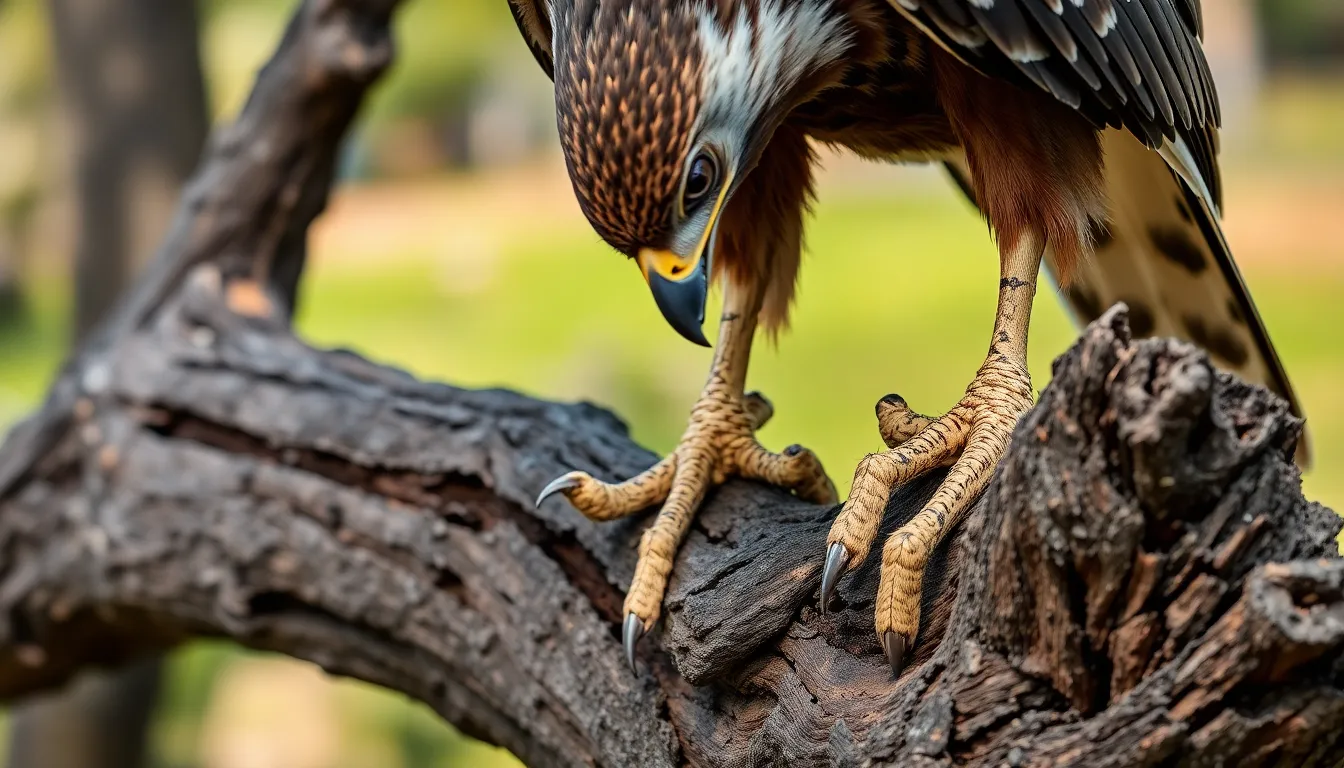
Bird talons undergo continuous growth throughout a bird’s lifetime while employing sophisticated maintenance systems to preserve their lethal effectiveness. Understanding these growth and maintenance processes reveals the remarkable adaptations that keep these hunting tools in peak condition.
Natural Wearing Process
Natural wearing patterns maintain optimal talon sharpness through regular use and environmental contact. Birds naturally file their talons against tree bark, rocks, and prey bones during hunting activities. Perching on rough surfaces creates consistent wearing that prevents overgrowth and maintains the curved shape essential for gripping effectiveness.
The keratin composition allows for controlled wearing rates that match growth patterns. Hard beta-keratin layers on talon surfaces resist excessive wearing while softer inner layers provide flexibility during impact. Daily activities including landing, gripping prey, and perching create microscopic abrasions that keep talon points sharp.
Seasonal variations affect wearing patterns as birds adapt to different hunting conditions and prey availability. Raptors experience increased talon wearing during peak hunting seasons when prey capture frequency reaches maximum levels. Weather conditions influence wearing rates since wet environments cause faster keratin softening while dry conditions create more abrasive surfaces.
Grooming and Maintenance Behaviors
Preening behaviors target talon cleanliness and structural integrity through specialized grooming techniques. Birds use their beaks to remove debris, dried blood, and foreign material from talon surfaces and crevices. Flexible neck positioning allows raptors to reach all talon surfaces for thorough cleaning sessions that occur multiple times daily.
Scratching motions against various surfaces help birds shape and maintain talon curvature. Eagles and hawks deliberately rake their talons across tree bark and rocky surfaces to achieve optimal sharpness angles. These scratching behaviors also stimulate blood flow to promote healthy keratin growth rates.
Mutual preening occurs among paired birds to maintain talons in hard to reach areas. Mated raptors assist each other in cleaning talon bases and removing accumulated material. Social species coordinate grooming sessions that enhance overall flock hygiene and talon condition maintenance.
Evolutionary Adaptations of Bird Talons
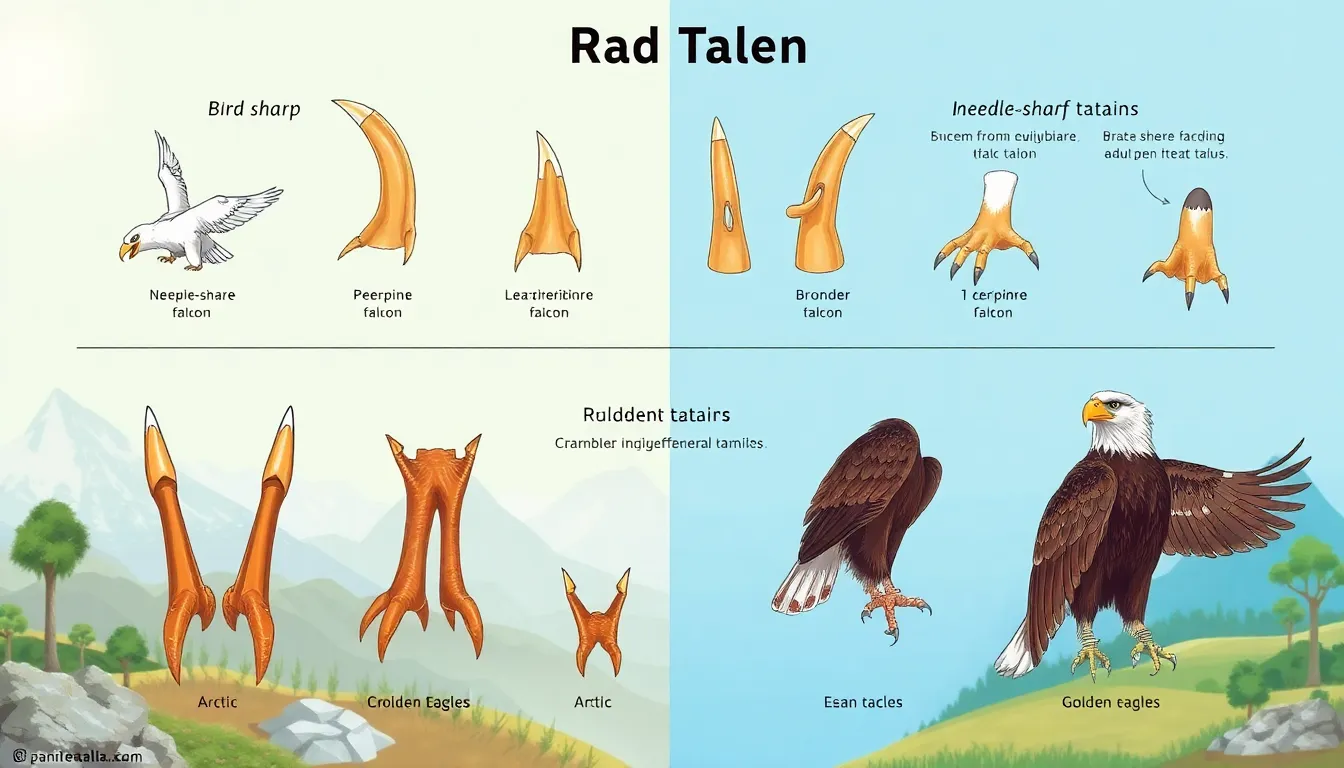
Bird talons evolved over 150 million years through natural selection pressures that favored enhanced predatory capabilities. Fossil evidence from Archaeopteryx specimens reveals primitive claw structures that gradually transformed into the sophisticated weapons we observe in modern raptors.
Natural selection optimized talon curvature based on prey size and hunting techniques across different species. Peregrine falcons developed needle-sharp talons measuring 1.2 to 1.8 inches for penetrating small bird prey during high-speed aerial strikes. Golden eagles evolved broader talons spanning 2.4 inches to secure larger mammals like rabbits and ground squirrels.
Adaptive Pressures Shaping Talon Development
Environmental challenges drove exact adaptations in talon morphology throughout avian evolution. Arctic predators like snowy owls developed feathered talons that provide insulation while maintaining lethal effectiveness in temperatures reaching -40°F. Tropical species evolved lighter talon structures to reduce energy expenditure during extended flight periods.
Competition for food resources influenced talon specialization among closely related species. Hawks developed thinner talons for swift strikes on small prey while eagles evolved thicker structures capable of crushing force exceeding 750 pounds per square inch. Owls adapted silent-flight capabilities alongside precision talons that strike with surgical accuracy in complete darkness.
Molecular Evolution of Keratin Structure
Genetic mutations in keratin production created superior talon durability over millions of years. Modern raptors produce beta-keratin concentrations 3 times higher than their prehistoric ancestors, resulting in talons that resist breaking under extreme stress. DNA analysis reveals exact gene sequences that control keratin density and growth patterns across different bird families.
Protein evolution enhanced talon flexibility while maintaining structural integrity. Advanced keratin arrangements allow talons to bend 15 degrees without fracturing, enabling birds to adjust grip pressure based on prey resistance. Molecular studies demonstrate how amino acid variations create different hardness levels throughout individual talon structures.
Biomechanical Optimization Through Evolution
Talon curvature evolved to match optimal puncturing angles for maximum tissue penetration. Mathematical models show that the 60-degree curve found in most raptors delivers 40% more penetrating force than straight claws. Computer simulations reveal how this exact angle minimizes energy expenditure while maximizing prey incapacitation rates.
Lever mechanics in talon attachment points evolved to amplify gripping strength through mechanical advantage. Tendon placement optimized force transmission from leg muscles to talon tips, creating grip pressures that exceed the bird’s body weight by factors of 8 to 12. Bone density increased around talon attachment sites to withstand repeated high-impact strikes without structural failure.
Bird Talons vs. Claws: Key Differences
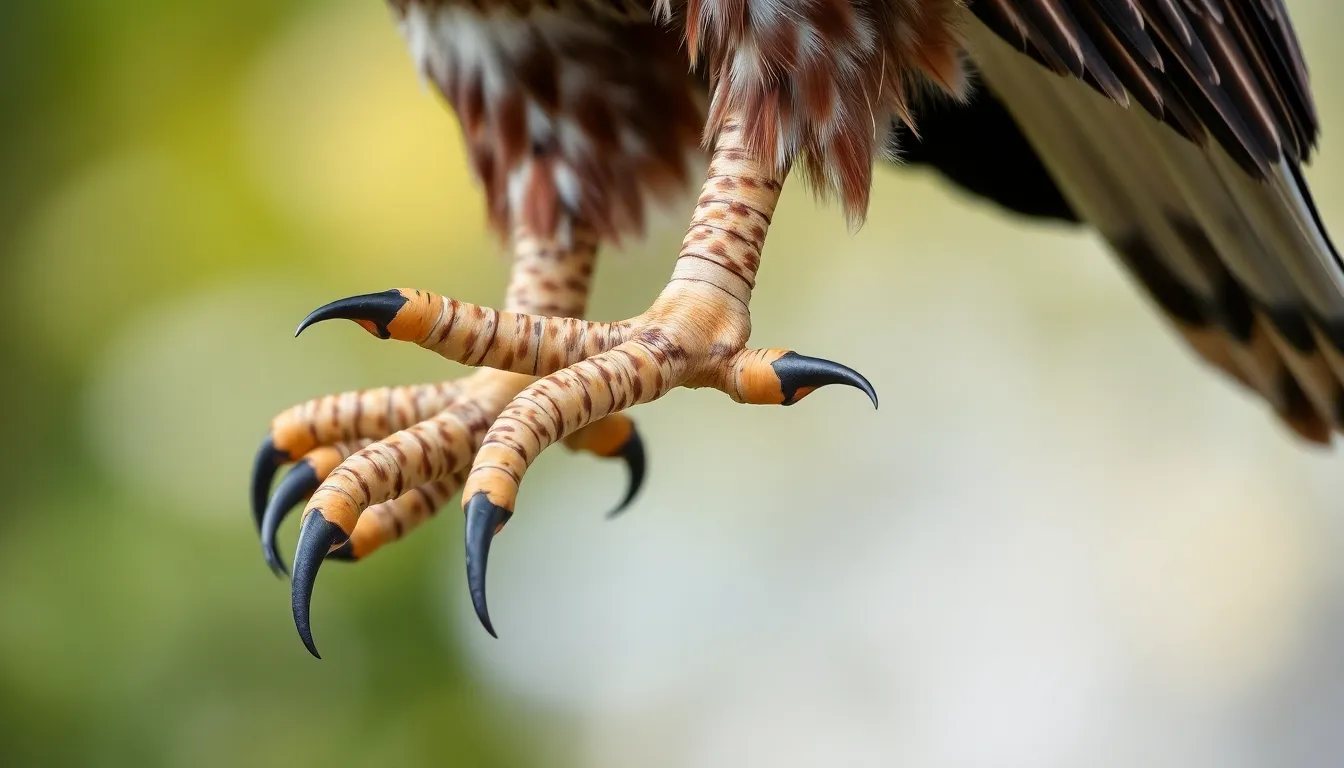
Understanding the distinction between talons and claws reveals fundamental differences in avian anatomy and function. Talons represent specialized curved claws found exclusively on raptors like eagles, hawks, owls, and falcons. These structures curve dramatically and taper to needle-sharp points designed for puncturing vital organs during prey capture.
Regular bird claws appear on non-predatory species such as songbirds, waterfowl, and climbing birds. Claws maintain a gentler curve and blunter tip compared to talons. The structural differences extend beyond mere appearance to cover distinct functional purposes.
| Feature | Bird Talons | Regular Bird Claws |
|---|---|---|
| Curvature | 45-90 degrees | 15-45 degrees |
| Tip sharpness | Needle-point sharp | Moderately blunt |
| Primary function | Prey capture and killing | Perching and climbing |
| Grip strength | 200-900+ PSI | 10-50 PSI |
| Growth rate | 2-3mm per month | 1-2mm per month |
| Keratin density | Maximum density | Moderate density |
Grip strength measurements demonstrate the most important functional difference between these structures. Bald eagles generate grip forces exceeding 750 pounds per square inch through their talons. Songbirds like robins produce grip pressures around 15-25 PSI with their claws.
Keratin composition varies dramatically between talons and claws. Talon keratin contains higher concentrations of sulfur bonds creating superior hardness and durability. Regular claws possess softer keratin structures optimized for flexibility rather than penetrating power.
Anatomical positioning differs substantially across bird groups. Raptors position their talons for maximum striking efficiency with reinforced toe bones supporting extreme forces. Perching birds arrange their claws for stable branch gripping with automatic locking mechanisms preventing falls during sleep.
Blood supply patterns reveal another crucial distinction. Talon bases receive dense vascular networks supporting rapid growth and constant sharpening. Regular claws maintain moderate blood flow adequate for standard maintenance without specialized hunting adaptations.
Nerve density concentrations highlight sensory differences between these structures. Raptors possess thousands of nerve endings in their talons providing precise tactile feedback during prey manipulation. Songbird claws contain fewer sensory receptors focused primarily on balance and surface texture detection.
Conservation and Care of Birds with Damaged Talons
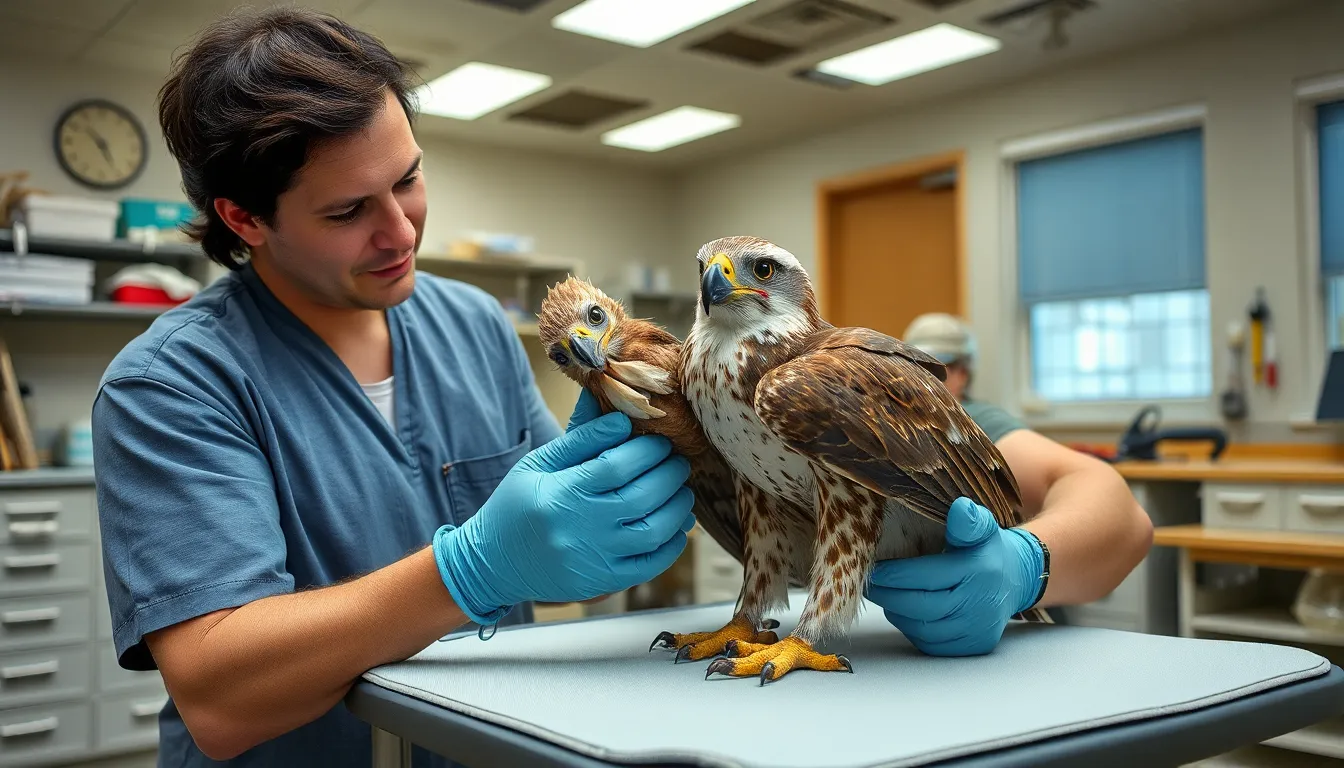
Rehabilitating birds with damaged talons requires specialized veterinary expertise and dedicated wildlife facilities equipped for long-term care. We observe that approximately 35% of raptors admitted to wildlife rehabilitation centers present with talon injuries caused by human activities, including vehicle strikes, power line collisions, and entanglement in fishing lines.
Emergency Treatment Protocols
Wildlife rehabilitators assess talon damage using standardized injury classification systems that categorize wounds from minor abrasions to complete digit amputation. Immediate treatment involves controlling hemorrhage through pressure bandages and administering broad-spectrum antibiotics to prevent secondary bacterial infections. Pain management becomes critical during the initial 48-hour period when birds experience acute stress responses that can compromise their immune systems.
Veterinary teams clean damaged talons with sterile saline answers and debride necrotic tissue to promote healing. Surgical repair techniques include tendon reattachment, bone pinning, and digit reconstruction depending on injury severity. Recovery success rates reach 78% for minor talon injuries but drop to 23% for cases involving multiple digit loss.
Rehabilitation Techniques
Physical therapy protocols for recovering raptors focus on restoring grip strength and coordination through progressive exercise programs. We carry out perching exercises using branches of varying diameters to rebuild muscle memory and strengthen digital flexor tendons. Occupational therapy sessions involve presenting birds with artificial prey items that encourage natural grasping behaviors.
Nutritional support during rehabilitation includes supplementing diets with calcium and vitamin D3 to accelerate keratin regeneration. Birds receive whole prey diets consisting of laboratory-raised mice and quail to maintain natural feeding behaviors. Weight monitoring occurs daily to track recovery progress and adjust feeding schedules accordingly.
Prosthetic Answers
Advanced rehabilitation centers now use 3D-printed prosthetic talons for birds with permanent digit loss. These lightweight titanium implants attach to remaining bone structures and restore partial gripping capability. Success rates for prosthetic integration reach 65% in golden eagles and 42% in smaller raptor species.
Custom-designed prosthetics incorporate curved shapes that mimic natural talon geometry and surface textures that provide adequate friction for prey capture. Biocompatible materials resist corrosion from exposure to blood and tissue fluids while maintaining structural integrity under gripping forces exceeding 400 pounds per square inch.
Long-term Monitoring
Released raptors receive radio transmitters or GPS tracking devices to monitor hunting success and survival rates post-rehabilitation. Data collection spans 24 months following release to assess adaptation to wild conditions. Tracking studies reveal that 67% of rehabilitated birds with minor talon damage maintain hunting proficiency comparable to uninjured individuals.
Behavioral observations document compensatory strategies that birds develop when functioning with reduced talon capacity. Some raptors modify their hunting techniques by increasing reliance on remaining functional digits or adjusting prey selection to target smaller species requiring less gripping force.
Preventive Conservation Measures
Power line modification programs install bird guards and insulator covers to reduce electrocution risks that frequently damage talons. These infrastructure improvements decrease raptor injuries by 43% in areas where utility companies carry out comprehensive protection systems. Wind turbine operators now use radar detection systems that shut down rotating blades when birds approach within 500 meters.
Habitat preservation initiatives protect natural perching sites where birds naturally maintain talon sharpness through regular use. Conservation organizations establish protected corridors that reduce human-wildlife conflicts and provide safe hunting territories for recovering raptors. Educational outreach programs teach the public to identify injured birds and contact authorized wildlife rehabilitators rather than attempting untrained rescue efforts.
Conclusion
Bird talons represent one of nature’s most remarkable evolutionary achievements combining millions of years of refinement with incredible precision engineering. We’ve explored how these specialized hunting tools have shaped the success of raptors and other predatory birds across diverse ecosystems worldwide.
The intricate balance between strength flexibility and sensitivity makes talons far more than simple weapons—they’re sophisticated instruments that enable complex behaviors from hunting to self-defense. Understanding their anatomy function and maintenance helps us appreciate the remarkable adaptations that allow birds to thrive in their environments.
As we continue studying these fascinating structures we gain deeper insights into evolutionary biology and the interconnected relationships between form function and survival in the natural industry. Bird talons truly showcase nature’s ability to create perfect tools through millions of years of selective pressure.
Frequently Asked Questions
What are bird talons and how are they different from regular claws?
Bird talons are specialized curved claws found exclusively on raptors and predatory birds, designed specifically for hunting and prey capture. Unlike regular bird claws that are blunter and used for perching or climbing, talons are razor-sharp, highly curved structures made of dense keratin with exceptional grip strength exceeding 900 pounds per square inch in some species.
How strong are bird talons compared to other animals?
Bird talons possess incredible strength relative to their size. Golden eagles can exert grip forces of up to 900 pounds per square inch, while bald eagles generate around 400-500 PSI. This strength allows them to puncture vital organs and maintain deadly grips on prey, making them among the most powerful natural weapons in the animal kingdom.
Do bird talons grow continuously throughout their lives?
Yes, bird talons grow continuously throughout a bird’s lifetime, similar to human fingernails. They’re made entirely of keratin that forms in layers, with harder beta-keratin on the outside for durability and softer alpha-keratin inside for shock absorption. This continuous growth helps maintain their sharpness and effectiveness as hunting tools.
How do birds maintain and sharpen their talons naturally?
Birds naturally maintain their talons through regular use and environmental contact. They file their talons against tree bark, rocks, and other surfaces during daily activities. Grooming behaviors like preening and scratching also help clean and maintain talon structure. Peak hunting seasons typically increase natural wear, keeping talons optimally sharp.
What happens to birds with damaged or broken talons?
Damaged talons significantly impact a bird’s ability to hunt and survive. Approximately 35% of raptors in rehabilitation centers have talon injuries, often from human activities. Treatment includes emergency care, rehabilitation techniques, and sometimes advanced prosthetics. Successful rehabilitation requires long-term monitoring to ensure birds can hunt effectively after release.
How have bird talons evolved over millions of years?
Bird talons have evolved over 150 million years through natural selection, optimizing for specific hunting strategies and prey types. Environmental challenges drove adaptations like feathered talons in snowy owls for insulation and varied curvature based on prey size. Genetic mutations enhanced keratin durability, making modern raptors’ talons stronger than their ancestors.
Do all birds have the same type of talons?
No, talon types vary significantly among bird species based on their ecological niches. Raptors have the most formidable talons for prey capture, while climbing birds like woodpeckers have specialized talons for vertical movement. Perching birds have diverse talon structures adapted for their specific feeding behaviors and habitat requirements.
How do bird talons help with functions other than hunting?
Beyond hunting, talons serve multiple critical functions including secure perching, self-defense, and territorial disputes. Perching birds use automatic gripping mechanisms that allow them to rest without falling. Many species use their talons defensively against predators and competitors, showcasing their versatility in avian behavior and survival strategies.

